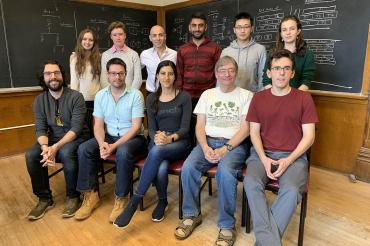Scholars-in-Residence program offers U of T undergraduate students immersive research experience

U of T students worked with Hakob Barseghyan, assistant professor in the Institute for the History and Philosophy of Science and Technology, to analyze belief systems throughout history using a diagramming approach (photo by Adriana Leviston)
Published: August 13, 2019
It’s a unique, immersive research experience that allows undergraduate students to spend four weeks working on projects with faculty members from across the humanities.
This summer’s Scholars-in-Residence (SiR) program, run by the Jackman Humanities Institute and Victoria College, marked the fourth year that successful applicants took part in the residency in humanities and humanistic social science research.
Students from across the Faculty of Arts & Science, as well as U of T Mississauga and U of T Scarborough, participated in this year’s program. Participants are granted free accommodation in on-campus housing and a meal plan for the duration of the program, as well as a $1,000 Jackman Scholar Award.
Participants say the opportunities to contribute to original faculty research projects and build new relationships with peers and professors are the biggest rewards.
“SiR is not only an intensive research program, it also allowed me to network and meet an incredible diversity of students outside of my faculty and college,” says Trinity College student Kat Yampolsky, a second-year specialist in peace, conflict and justice studies with a double minor in Italian and Arabic. “I would 100 per cent recommend the program to other students.”
Since its inception, the program has rapidly expanded. What started as a 20-student pilot in 2016 on the St. George campus has now grown into 100 participating students, with some research teams hosted at U of T Mississauga and U of T Scarborough in the last two years.
Faculty members from across the humanities work with student researchers on a variety of projects. Some students helped transcribe and annotate 18th-century letters written in French between journalists and publishers, while others worked on an audience research study to examine the representation of minorities in the CBC sitcom Kim’s Convenience.
Students paired with Hakob Barseghyan, assistant professor in the Institute for the History and Philosophy of Science and Technology, analyzed particular belief systems throughout history using a diagramming approach to turn historical data into easily comprehensible visualizations.
Fourth-year Trinity College student Jessica Rapson, who studies psychology and philosophy, diagrammed the Aryan physics worldview, a product of Nazi ideology that existed briefly in the 1930s.
“Few people know about the strange anachronistic scientific beliefs that flourished in the Nazi regime,” says Rapson. “I hope my project will help historians analyze why well-respected scientists –including Nobel Prize-winners – accepted the extremely questionable scientific theories proposed by Aryan science. These include parapsychology – a belief in things like ESP or telepathy – and the notion that the most fundamental particle in the universe is ice.”
Kye Palider, a Victoria College student who is entering his fourth year this fall as a physics and philosophy joint specialist with a history and philosophy of science minor, focused his diagramming on 20th -century scientific methodology in the physical and mathematical sciences.
“The kind of diagramming we’re doing can prove useful in pedagogy, clarifying arguments and finding weak points in essays,” he says of Barseghyan’s project.
Program director Angela Esterhammer, also a professor in the department of English, says SiR has been a “transformative experience” for students and faculty alike.
“Students say the experience gives them new insight into critical thinking, community-engaged research and what it means to be a scholar working with primary sources,” she says.
“The program also opens up career choices by demonstrating how research skills in the humanities can be applied in broader social, economic and cultural contexts. Meanwhile, faculty find that the results produced by their students exceed their expectations. An intense month of working with these talented undergraduates often reveals new approaches to their research.”
Another SiR project is Timothy Sayle’s “Unlocking the Nuclear Vault,” an ongoing, multi-year examination of formerly top secret documents related to Canada and nuclear weapons in the Cold War. Sayle, an assistant professor in the department of history, has led SiR groups in past years and continues to believe in the program’s merits.
“This is really all about our tremendous undergraduates,” says Sayle. “One of the most exciting things as a supervisor is to see how our students work together as a team. It’s incredible.”
One of Sayle’s students, Victoria College’s David de Paiva, is majoring in political science and urban studies, with a minor in Russian literature in translation – a fitting combination for the Cold War project. He was particularly enthusiastic about the groundbreaking nature of the work.
“As we are some of the first scholars outside government to see these files,” says de Paiva, “we’re able to actively participate in the revision and rewriting of history from an accurate, informed perspective. As an undergrad, this is a very unusual and rewarding experience.”
Regardless of their academic accomplishments, SiR students all commented on the lifelong friendships and collaborative relationships they formed during the intensive month-long residency.
“I’m a humanities student,” says Yampolsky, “and one of my closest friends became a math, physics and philosophy student. Where else would I have had the opportunity to work with someone from a polar opposite academic background?”
“SiR is an opportunity to befriend like-minded student researchers and professors and do so in an atmosphere free of the stress of grading or assignment deadlines,” says de Paiva. “It’s how learning should be all the time.”
Topics
Arts & Science



